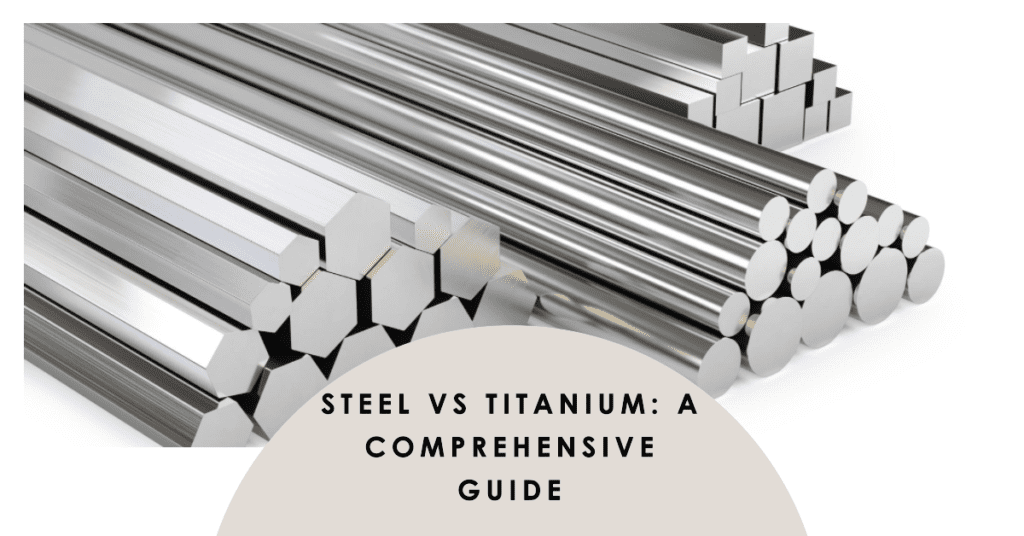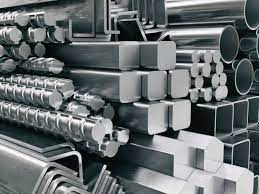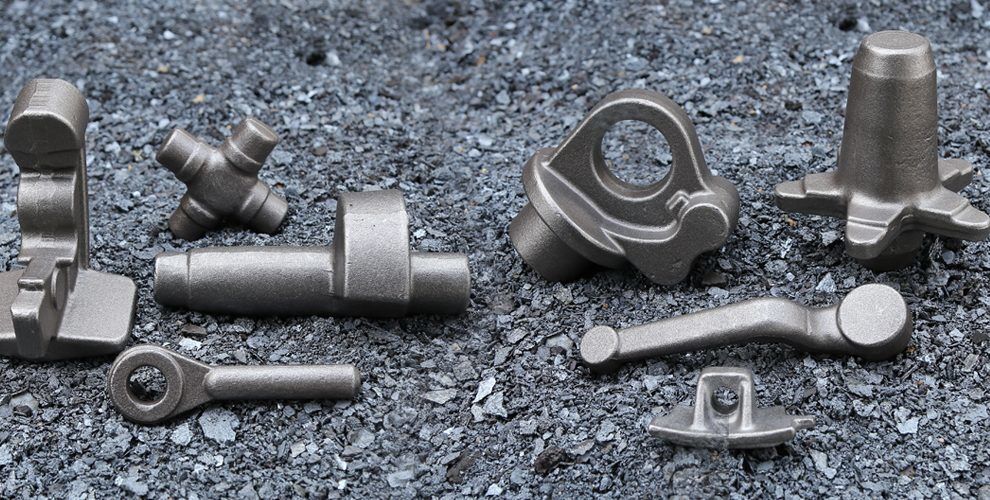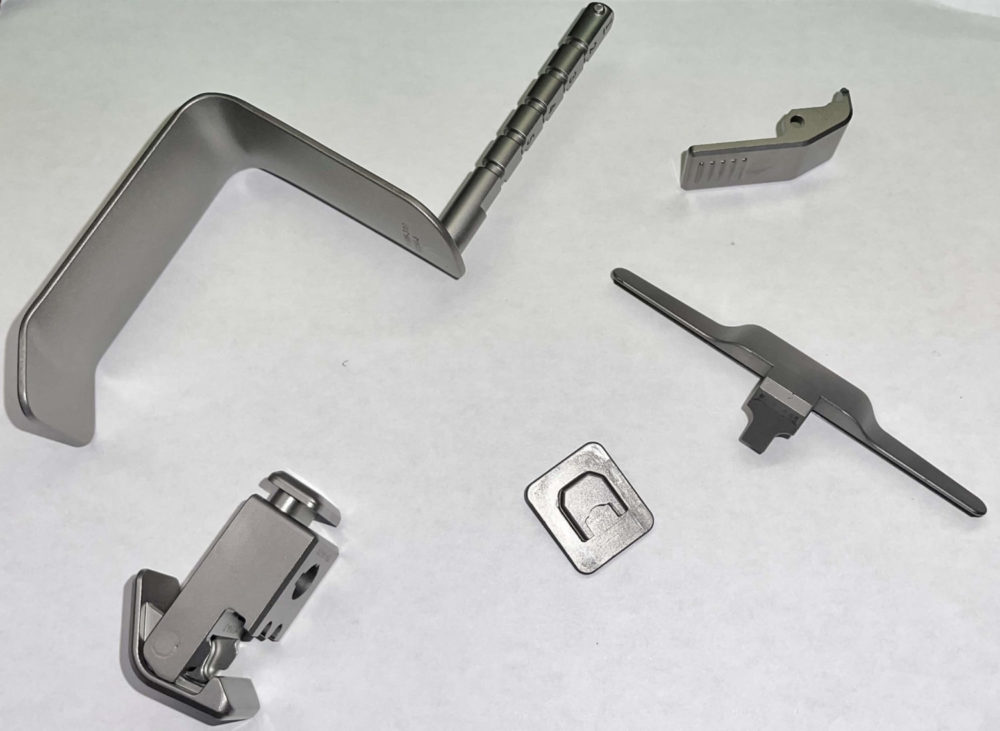Choosing the right metal for a particular application can be a daunting task. Several factors are to consider, including strength, weight, corrosion resistance, cost, etc. Titanium and steel, in particular, are two metals that are often compared due to their widespread use across various industries. However, understanding the fundamental differences between steel properties and titanium properties is key to making the right choice for your specific needs.
Our comprehensive guide will take you through the ins and outs of these two popular materials, providing insights into their properties, usage across various sectors, and how to decide between them.
Steel and Titanium: A Basic Overview
Steel and titanium are popular metals in manufacturing due to their excellent strength, hardness, and other physical and mechanical properties. Let’s briefly delve into the details of each.
Unpacking the Basics: What is Steel?
Raw steel in different forms
Steel alloy is composed of iron and carbon, with the carbon content varying from 0.2% to 2.1% by weight. While iron and carbon are the main constituents, other elements, such as manganese, silicon, and phosphorus, may also be present in minor amounts. There are several types of steel, classified based on their carbon content, alloying elements, and heat treatment processes. These include mild steel, stainless steel, and high-strength, low-alloy steel, among others.
Steel is known for its strength, durability, and versatility, which make it suitable for a wide range of applications. Its usage spans from construction and automotive to tools and cutlery.
Into the World of Lightweight Strength: What is Titanium?

Titanium swarfs, metal chips
Scrap Titanium
Titanium is a chemical element with the symbol Ti and atomic number 22. It’s a lustrous transition metal with a silver color, low density, and high strength. While it’s as strong as steel, it’s significantly less dense, making it the go-to metal for applications where the strength-to-weight ratio is crucial.
In its unalloyed condition, titanium is as strong as some steels but less dense. When alloyed with other elements such as aluminum and vanadium, it can be significantly strengthened.
The two primary uses of titanium are in aerospace (aircraft, spacecraft, and missiles) and industrial applications due to its lightness, strength, and resistance to corrosion even at high temperatures.
Delving into the Properties: Steel Vs Titanium
Strength and Weight: A Comparative Look
When comparing the strength and weight of steel and titanium, it’s important to note that different types of steel and titanium alloys can have different properties. However, on a general level, steel is known for its exceptional strength and is often heavier than titanium.
On the other hand, titanium has the highest strength-to-density ratio of any metallic element. This means that while it may not be as strong as certain types of steel, it is much lighter, making it an excellent choice for applications where weight is a crucial consideration, such as in the aerospace industry.
Corrosion Resistance: A Key Difference
One area where titanium truly outshines steel is in its resistance to corrosion. While certain types of steel, like stainless steel, have good corrosion resistance, they can’t match titanium. Titanium forms a layer of titanium dioxide on its surface, protecting the underlying metal from a wide range of corrosive environments. This makes it an excellent choice for applications such as marine hardware, chemical processing plants, and medical implants.
Note: It’s crucial to remember that these properties can vary based on the specific type of steel or titanium alloy, as well as the processing and treatment the material has undergone.
Comparison of Physical, Mechanical, and Chemical Properties
Understanding the physical, mechanical, and chemical properties of both steel and titanium is crucial when selecting the most suitable material for specific applications. These characteristics govern how each material behaves under various conditions.
1. Physical Properties
Physical properties relate to the state of the material in its purest form and its response to changes in temperature, pressure, and volume. Key physical properties include density, melting point, and thermal conductivity.
| Property | Steel | Titanium |
|---|---|---|
| Density (g/cm³) | 7.85 | 4.51 |
| Melting Point (°C) | 1370 – 1538 | 1668 |
| Thermal Conductivity (W/m.K) | 15-50 | 21.9 |
2. Mechanical Properties
Mechanical properties dictate how a material will respond to forces applied to it. These properties include strength, ductility, and hardness.
| Property | Steel | Titanium |
|---|---|---|
| Tensile Strength (MPa) | 370 – 500 | 1000 – 1200 |
| Yield Strength (MPa) | 250 – 355 | 830 – 895 |
| Hardness (Brinell) | 120 – 160 | 240 – 280 |
3. Chemical Properties
The chemical properties of a material describe how it reacts with other substances. The most relevant chemical property for both steel and titanium is their resistance to corrosion.
| Material | Corrosion Resistance |
|---|---|
| Steel | Generally prone to rust, but stainless steel has good resistance due to the chromium content |
| Titanium | Excellent resistance to corrosion in most environments due to the formation of a protective oxide layer |
Table 3: Comparison of the corrosion resistance of steel and titanium.
Try Prolean Now!
Steel Vs Titanium in Various Industries
The applications of steel and titanium span a multitude of industries. While both materials exhibit a blend of strength and durability, the choice between the two often comes down to specific requirements such as weight, corrosion resistance, and cost.
Automotive Industry: A Race for Efficiency
Automotive parts made from forged steel
In the automotive industry, both steel and titanium have found extensive use. Steel, given its strength and cost-effectiveness, is used heavily in vehicle structures, body panels, engine parts, and more. However, with the increasing demand for fuel-efficient vehicles, there is a push for lighter materials. This is where titanium comes into play.
Titanium, with its impressive strength-to-weight ratio, is finding its way into high-performance vehicles and parts such as connecting rods, valves, and exhaust systems. While it is more expensive than steel, the improved fuel efficiency can often offset this cost over time.
| Metal | Used in Automotive Industry |
|---|---|
| Steel | Vehicle structure, body panels, engine parts |
| Titanium | High-performance parts like connecting rods, valves, and exhaust systems |
Construction: Building on Strength
The construction industry has long favored steel for its strength, durability, and recyclability. Steel is a key component in structural applications, including beams, columns, and trusses. It’s also widely used in roofing, flooring, and HVAC systems.
Titanium, on the other hand, is rarely used in large-scale construction projects due to its higher cost. However, its corrosion resistance makes it suitable for specific applications, such as coastal structures exposed to saltwater or structures that require resistance against specific chemical environments.
| Metal | Used in Construction Industry |
|---|---|
| Steel | Structural applications, roofing, flooring, HVAC systems |
| Titanium | Coastal structures, chemically harsh environments |
Medical Applications: The Surgeon’s Choice
Few medical applications of Titanium
In the medical field, the choice of material must consider not just strength or weight, but also biocompatibility. Both stainless steel and titanium are used in various medical applications, from surgical instruments to implants.
Stainless steel is commonly used for surgical instruments due to its strength, durability, and sterilization capability. However, for implants that stay within the body, titanium is often the material of choice. This is because titanium is more biocompatible than steel, meaning it’s less likely to be rejected by the body. It also has a lower modulus of elasticity, making it more similar to human bone and thus more comfortable for the patient.
| Metal | Uses in Medical Industry |
|---|---|
| Steel | Surgical instruments |
| Titanium | Implants, surgical instruments |
The Economics of Steel and Titanium
In addition to physical properties, the economic aspects of using either steel or titanium is an important consideration in material selection. This covers not just the cost per pound, but also the longer-term implications such as life-cycle cost, availability, and market stability.
1. Upfront Costs
When comparing the upfront cost of materials, steel is significantly less expensive than titanium. This is due in part to the abundance of iron, a key ingredient in steel, and the more complex extraction and processing methods required for titanium.
However, the total cost of a part is not only determined by the cost of the material but also includes manufacturing and processing costs. Titanium parts can be more expensive to manufacture due to the need for specialized machinery and longer machining times.
2. Long-term Costs
While the upfront costs of titanium are higher, it’s crucial to consider the long-term costs of operation, maintenance, and replacement. In certain applications, the high strength, lightweight, and corrosion resistance of titanium can result in lower overall costs over the lifespan of a product or project. For example, titanium parts in an aircraft or marine environment may require less frequent replacement and maintenance due to corrosion, leading to lower long-term costs.
Sustainability: Steel Vs Titanium
Sustainability is an increasingly important consideration in material selection. Both steel and titanium have different strengths and challenges when it comes to environmental impact.
1. Production and Processing Impact
Steel production is a significant emitter of greenhouse gases, mainly due to the energy-intensive nature of the process and the use of coal in the blast furnace process. However, steel is highly recyclable and has a well-established recycling infrastructure, which helps to offset some of these emissions.
Titanium production, while also energy-intensive, doesn’t require the use of coal and therefore has lower direct CO2 emissions. However, the extraction and refining processes can have significant environmental impacts, including habitat destruction and water pollution.
2. Life-cycle Impact
When considering the life-cycle environmental impact, it’s important to look at the use phase and end-of-life phase. Steel’s high recyclability means that it has a lower end-of-life impact than many materials. However, products made from steel may have higher impacts during use due to the material’s weight, particularly in transportation applications.
Titanium’s light weight can lead to lower environmental impacts during use, especially in applications like transportation where weight influences fuel efficiency. However, titanium is less commonly recycled than steel, largely due to lower demand and higher processing costs.
Making the Right Choice: Steel or Titanium?
Selecting the appropriate material for a particular application involves consideration of the specific requirements of that application, including the physical, mechanical, and chemical properties required, the cost constraints, and the sustainability considerations.
1. Consider the Application
Some applications may need high strength and durability, while others may prioritize weight or corrosion resistance. For example, for applications that require strength and cost-effectiveness, steel is often the better choice. But in environments where corrosion is a major concern, or where weight is a critical factor, titanium CNC machining may be more appropriate.
2. Factor in the Costs
While steel is generally less expensive than titanium, considering the entire life-cycle costs can sometimes tilt the balance in favor of the more expensive material. For example, the lower maintenance and longer life of titanium parts can sometimes outweigh the higher upfront cost, particularly in high-performance or demanding environments.
3. Think About Sustainability
Finally, sustainability considerations may play a role in the decision. Steel’s high recyclability is a significant plus in its favor, but for applications where weight impacts energy use, the lightness of titanium can lead to lower carbon footprints during the use phase.
In the end, there’s no one-size-fits-all answer to the steel vs. titanium question. The best material for a given application will depend on a careful analysis of all these factors, guided by the expertise of engineers and materials scientists.
The table below table outlines the steps involved in making the right choice between machining titanium vs steel:
| Step | Description |
|---|---|
| Identify the Requirements of the Application | Understand the specific needs of the application. What physical, chemical, and mechanical properties are needed? Is there a need for high strength, corrosion resistance, or lightness? |
| Analyze Material Properties | Study the properties of both steel and titanium. Review the strengths and weaknesses of each in terms of their physical, mechanical, and chemical characteristics. |
| Consider the Costs | Look at both the upfront cost and the lifecycle cost of each material. While steel may be cheaper initially, the maintenance and longevity of titanium could make it more cost-effective in the long run. |
| Evaluate Sustainability | Examine the environmental impact of each material. While steel is highly recyclable, the lightness of titanium may reduce energy consumption in certain applications. |
| Consult with Experts | Before making a final decision, consult with materials scientists or engineers who have a deep understanding of both materials and their various applications. They can provide invaluable insights that can help you make an informed choice. |
Prolean’s Metal Machining and Fabrication Services
At Prolean, we offer top-tier metal machining and fabrication services, making us the perfect partner for your steel and titanium needs.
| Service | Description | Suitable Materials |
|---|---|---|
| EDM Services | Precise shaping of robust materials | Steel and Titanium |
| CNC Services | Custom parts with impeccable accuracy, repeatability, and speed | Steel and Titanium |
| Waterjet Cutting Services | Exceptional precision without heat-affected zones | Steel and Titanium |
| Plasma Cutting Services | Cost-effective and efficient for thicker steel | Steel |
| Fabrication Services | Welding, bending, forming, and assembly | Steel and Titanium |
At Prolean, we’re equipped to handle projects of any size and complexity. Our commitment to quality, combined with our wide range of services, makes us the go-to solution for all your steel and titanium machining and fabrication needs. Our team works with you to select the best machining and fabrication techniques for your specific project, ensuring a high-quality, cost-effective result. Trust Prolean for all your metal machining and fabrication needs.
Conclusion
In the world of materials science and engineering, choosing between steel and titanium is not a matter of superior or inferior; it’s about what’s most suitable for the task at hand. Both materials offer their unique properties, advantages, and disadvantages. Steel, often less expensive and stronger, has its firm place in infrastructure and automotive industries. Titanium, though costly, offers unparalleled lightness, strength, and corrosion resistance, making it a top choice in aerospace, medical implants, and sporting goods.
The ultimate decision relies heavily on the specific application, cost-effectiveness, and sustainability aspects. Always involve materials scientists or engineers to guide the decision-making process to ensure the best material is chosen for the task. So, you can request a quote for your custom machining steel parts.
Read more: CNC Machining Titanium Vs Aluminum: Choose The Best Metal
FAQ’s
Is titanium stronger than steel?
While it’s true that titanium has a higher strength-to-weight ratio than steel, steel itself is generally stronger. However, due to its lighter weight, titanium can be an excellent choice for applications where weight is a critical factor.
Why is titanium more expensive than steel?
Titanium is more expensive to produce than steel due to its rarity and the complex processes involved in extracting it and refining it into a usable form. Also, the overall demand for titanium is less than that of steel, keeping the prices high.
Is titanium as durable as steel?
Titanium is highly durable and resistant to corrosion, even in harsh environments. While steel, particularly stainless steel, is also durable, it may be prone to rust in certain conditions. The type of steel and its treatment can significantly influence its durability.
Can titanium be recycled like steel?
Yes, titanium can be recycled, although the process is more complex than steel. However, because titanium parts often have a longer lifespan than their steel counterparts, they may not enter the recycling stream as frequently.
When should I choose steel over titanium?
Steel is often chosen for its cost-effectiveness, strength, and versatility. It’s a good choice for applications where weight is not a significant concern, and where high strength is needed. However, the final choice should always consider the specific requirements of the application.









0 Comments